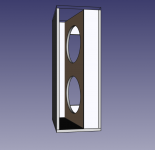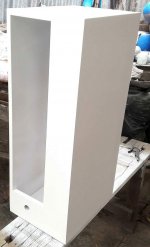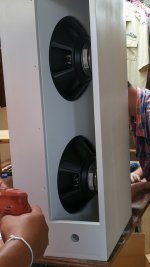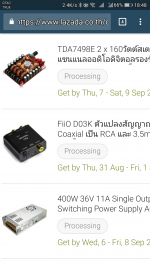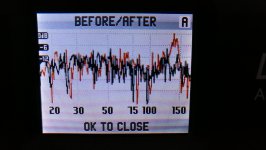I am about to embark on a quite complex (for me anyway) project and was looking for opinions on the chosen direction.
For our living room I have bought a pair of small monitors, using Tang Band drivers.
I like the performance, but when listening to rock or classical, I am missing bass.
Initially I was planning on experimenting with replacing the drivers, but adding stereo subwoofers might be more fun as a project.
The 'N-Frame' layout looks like an easy build and the small front will score points too 😉
The stands should be about 60 .. 65 cm (24" .. 26") high, that enables the use of 2 drivers.
From the drivers available here, I have a preference for the Dayton Audio DCS255-4 10" Classic. This based on availability, price and reading reviews.
Using Sketchup I made the attached model.
I can cheat a little bit, from the end of May I can use a DSPeaker Antimode 2 and some class D amplifiers; In a later stage I would like to use something like a miniDSP.
More cheating, the enclosures (baffles?) will be made by someone else.
My questions:
- Given the cheats, could this work?
- Is the selected driver any good in this type of frame? or more generic: What parameters/values should I be looking for when selecting a driver for this type of frame?
Thanks for reading and please be firm but gentle when responding 😀
For our living room I have bought a pair of small monitors, using Tang Band drivers.
I like the performance, but when listening to rock or classical, I am missing bass.
Initially I was planning on experimenting with replacing the drivers, but adding stereo subwoofers might be more fun as a project.
The 'N-Frame' layout looks like an easy build and the small front will score points too 😉
The stands should be about 60 .. 65 cm (24" .. 26") high, that enables the use of 2 drivers.
From the drivers available here, I have a preference for the Dayton Audio DCS255-4 10" Classic. This based on availability, price and reading reviews.
Using Sketchup I made the attached model.
I can cheat a little bit, from the end of May I can use a DSPeaker Antimode 2 and some class D amplifiers; In a later stage I would like to use something like a miniDSP.
More cheating, the enclosures (baffles?) will be made by someone else.
My questions:
- Given the cheats, could this work?
- Is the selected driver any good in this type of frame? or more generic: What parameters/values should I be looking for when selecting a driver for this type of frame?
Thanks for reading and please be firm but gentle when responding 😀
Attachments
Dipoles (including folded baffle designs) are horribly inefficient at producing low bass. What kind of bandwidth are you aiming for? Depending on your design goals, and simple Linkwitz-transformed sealed box might be a much better solution.
Hi, the tang bands drop of at 85Hz if I remember correctly.
With the subs I would like to go below 40Hz.
According to the specs, in a sealed cabinet F3 would be about 78 Hz for the Daytons.
And, in my imagination, sealed with the drivers at the side would look strange; As if they are placed wrong.
With the subs I would like to go below 40Hz.
According to the specs, in a sealed cabinet F3 would be about 78 Hz for the Daytons.
And, in my imagination, sealed with the drivers at the side would look strange; As if they are placed wrong.
Have you already read up on open baffles?
This is a primer, with good links.
mh-audio.nl - Home
Yea, if your amp is OK with a 2 ohm load. You might get a mild benefit from flipping one driver, so one faces forward, one backward.
With a DSP and plenty of power, you can equalise any woofer to get any response you want.
In an inefficient build, the excursion requirements are high, so displacement is important if you want it to play loud(ish). Therefore, if price is a factor, the best driver is one that gives lots of displacement (area x excursion) per dollar.
Based on this write-up:
http://www.quarter-wave.com/OBs/OB_Design.pdf
...if an Eminence 15" (displacement: 325ml) is enough to keep up with a 4" Fostex, then a pair of the Dayton 10" (each has displacement 287ml) should be more than enough to keep up with your TB mains.
I get about 60Hz in a 20 litre box. -12dB at 30Hz.
An OB with effective width of 50cm will rolloff at 6dB/octave below ~200 Hz, so will be -12dB at 50Hz just from baffle cancellation. Below the driver Fs, the rolloff will be 18dB/octave.
Therefore, the driver would need about 10dB more eq to reach 40Hz in an open baffle.
Grill cloth.
This is a primer, with good links.
mh-audio.nl - Home
My questions:
- Given the cheats, could this work?
Yea, if your amp is OK with a 2 ohm load. You might get a mild benefit from flipping one driver, so one faces forward, one backward.
- Is the selected driver any good in this type of frame? or more generic: What parameters/values should I be looking for when selecting a driver for this type of frame?
With a DSP and plenty of power, you can equalise any woofer to get any response you want.
In an inefficient build, the excursion requirements are high, so displacement is important if you want it to play loud(ish). Therefore, if price is a factor, the best driver is one that gives lots of displacement (area x excursion) per dollar.
Based on this write-up:
http://www.quarter-wave.com/OBs/OB_Design.pdf
...if an Eminence 15" (displacement: 325ml) is enough to keep up with a 4" Fostex, then a pair of the Dayton 10" (each has displacement 287ml) should be more than enough to keep up with your TB mains.
With the subs I would like to go below 40Hz.
According to the specs, in a sealed cabinet F3 would be about 78 Hz for the Daytons.
I get about 60Hz in a 20 litre box. -12dB at 30Hz.
An OB with effective width of 50cm will rolloff at 6dB/octave below ~200 Hz, so will be -12dB at 50Hz just from baffle cancellation. Below the driver Fs, the rolloff will be 18dB/octave.
Therefore, the driver would need about 10dB more eq to reach 40Hz in an open baffle.
And, in my imagination, sealed with the drivers at the side would look strange; As if they are placed wrong.
Grill cloth.
Yes, I have read quite a lot of information, but there is not a lot about selecting drivers based on T/S parameters for specific enclosures/baffles.
I have 4 (old) UCD180's locked away in storage, so each driver gets its own amp.Yea, if your amp is OK with a 2 ohm load. You might get a mild benefit from flipping one driver, so one faces forward, one backward.
Should be sufficient 🙂
Re the backward placement: The motor (without cloth) would be visible from the couch. I'm not sure this would get past the planning board...
To me this reads: feasible 🙂With a DSP and plenty of power, you can equalise any woofer to get any response you want.
In an inefficient build, the excursion requirements are high, so displacement is important if you want it to play loud(ish). Therefore, if price is a factor, the best driver is one that gives lots of displacement (area x excursion) per dollar.
Based on this write-up:
http://www.quarter-wave.com/OBs/OB_Design.pdf
...if an Eminence 15" (displacement: 325ml) is enough to keep up with a 4" Fostex, then a pair of the Dayton 10" (each has displacement 287ml) should be more than enough to keep up with your TB mains.
I get about 60Hz in a 20 litre box. -12dB at 30Hz.
An OB with effective width of 50cm will rolloff at 6dB/octave below ~200 Hz, so will be -12dB at 50Hz just from baffle cancellation. Below the driver Fs, the rolloff will be 18dB/octave.
Therefore, the driver would need about 10dB more eq to reach 40Hz in an open baffle.
😀Grill cloth.
Thanks for your reply, very useful.
Finally some progress...
Being a foreigner in Thailand makes things quite interesting, and being a newbie on building speakers doesn't help either 🙂
However, I have found a shop that can build the cabinets.
It took a while, the CNC shops I found in my area only do advertisement displays.
Even when they claim to work with MDF, they only do Perspex.
The cabinet grew from 60..65cm to about 80 cm high, so my tang bands end up at the correct height.
This meant I could use a larger driver; I ordered "GRS 12PR-8", a 12" driver with a Qts of 1.24.
For the project I need 4 and to compensate for my capabilities I added 2 spares.
I decided to go for these drivers, as they are available over here and affordable, although almost double of what they go for at parts express.
The first drawings were made with Sketchup, the attached drawing is made with FreeCAD.
Being a foreigner in Thailand makes things quite interesting, and being a newbie on building speakers doesn't help either 🙂
However, I have found a shop that can build the cabinets.
It took a while, the CNC shops I found in my area only do advertisement displays.
Even when they claim to work with MDF, they only do Perspex.
The cabinet grew from 60..65cm to about 80 cm high, so my tang bands end up at the correct height.
This meant I could use a larger driver; I ordered "GRS 12PR-8", a 12" driver with a Qts of 1.24.
For the project I need 4 and to compensate for my capabilities I added 2 spares.
I decided to go for these drivers, as they are available over here and affordable, although almost double of what they go for at parts express.
The first drawings were made with Sketchup, the attached drawing is made with FreeCAD.
Attachments
I fear you will experience a significant amount of vibration/rocking from this setup. The driver will have to move frantically to generate any appreciable SPL. Because the footprint is tall and has a narrow base, there is opportunity for the inertia of the driver cone movement to be significant WRT the stiffness and mass of your "N-frame".
I have experienced this problem with my own open baffle subwoofers.
I have experienced this problem with my own open baffle subwoofers.
^ agreed, if the worst does happen you could experiment by cutting them in half and arranging them push-push which will cancel the cabinet forces
I agree with last two posts, you can put something heavy on top of the cab like a slab of granite/marble 1 1/2 - 2 inches thick will help but your cab is tall. If thecab is not stable drivers could go wild.
Thanks guys, learning all the time.
If I understand correctly, the movement of the 2 cones (and air?) could be a problem, because their moving mass might rock the enclosure?
And it would be a bigger problem than rocking caused by movement of the air, front and back?
The driverpanel is removable, so the panel can easily be replaced by one with a single driver.
Incidentally, the enclosures for full range speakers that will be placed on top are made of marble.
As they are nearly done, I will use them as-is and try to make it work.
If the rocking is too big an issue, I can replace the panels (and/or the drivers).
But, that would mean I have at least succeeded at getting the whole system to work...
If I understand correctly, the movement of the 2 cones (and air?) could be a problem, because their moving mass might rock the enclosure?
And it would be a bigger problem than rocking caused by movement of the air, front and back?
The driverpanel is removable, so the panel can easily be replaced by one with a single driver.
Incidentally, the enclosures for full range speakers that will be placed on top are made of marble.
As they are nearly done, I will use them as-is and try to make it work.
If the rocking is too big an issue, I can replace the panels (and/or the drivers).
But, that would mean I have at least succeeded at getting the whole system to work...
Action and reaction, that's why push-push is good. Sorry no-one picked up on this problem earlier. Let us know how you get onThanks guys, learning all the time.
If I understand correctly, the movement of the 2 cones (and air?) could be a problem, because their moving mass might rock the enclosure?
And it would be a bigger problem than rocking caused by movement of the air, front and back?
The enclosures are finished.
On the photo the SpeakOn's are being added.
I have thought some more about the possible rocking.
If it occurs, I will fix the enclosure to a base plate, to increase the effective width.
But, the assembly is quite rigid and heavy; I hope it's OK as-is.
On the photo the SpeakOn's are being added.
I have thought some more about the possible rocking.
If it occurs, I will fix the enclosure to a base plate, to increase the effective width.
But, the assembly is quite rigid and heavy; I hope it's OK as-is.
Attachments
You could reverse one driver, it could cancel some non-linearities and it would balance the centre of gravity
You could reverse one driver, it could cancel some non-linearities and it would balance the centre of gravity
That isn't possible, the front's opening is too small, to allow sliding in/out of the driver panel, with woofers mounted on opposite sides.
Ready for the next step.
I have ordered 2 TDA7498 amplifier PCBs, a 400W 36V smps and 2 DACs.
All from Lazada, (similar to Amazon) and in total just over 100 euro.
I have read more about my DSPeaker's "2.2" capabilities, or lack thereof...
It seems I would have to add an analog crossover between the dsp and amplifiers. It can't output 4 different signals. It is strictly 2-channel.
I don't want to add a passive crossover, thus have to focus directly on dsp. More specifically, a miniDSP.
The nanodigi 2x8 seems to cover my needs, but it looks a bit dated (found a thread here started in 2011.) I fear they will announce a replacement just after I ordered it...
I have ordered 2 TDA7498 amplifier PCBs, a 400W 36V smps and 2 DACs.
All from Lazada, (similar to Amazon) and in total just over 100 euro.
I have read more about my DSPeaker's "2.2" capabilities, or lack thereof...
It seems I would have to add an analog crossover between the dsp and amplifiers. It can't output 4 different signals. It is strictly 2-channel.
I don't want to add a passive crossover, thus have to focus directly on dsp. More specifically, a miniDSP.
The nanodigi 2x8 seems to cover my needs, but it looks a bit dated (found a thread here started in 2011.) I fear they will announce a replacement just after I ordered it...
Attachments
While waiting for the ordered items, I connected the 2 drivers in series.
This is connected in parallel with the tang band (which I have filtered with a 100u capacitor in series too).
The concept works. The photo shows the result of the original and corrected response, in the room.
So far, I am very happy with the results.
This is connected in parallel with the tang band (which I have filtered with a 100u capacitor in series too).
The concept works. The photo shows the result of the original and corrected response, in the room.
So far, I am very happy with the results.
Attachments
The search for DSP isn't really progressing.
All other parts have arrived, so I'm considering ordering the miniDSP to keep the momentum.
(Momentum is used loosely here 😀 )
I have just weighed the sub with the marble speaker: 29.8 kg.
How much power would be necessary to get 30kg rocking, when the enclosure is 30 cm wide, 40 cm deep and 80cm high?
All other parts have arrived, so I'm considering ordering the miniDSP to keep the momentum.
(Momentum is used loosely here 😀 )
I have just weighed the sub with the marble speaker: 29.8 kg.
How much power would be necessary to get 30kg rocking, when the enclosure is 30 cm wide, 40 cm deep and 80cm high?
- Status
- Not open for further replies.
- Home
- Loudspeakers
- Subwoofers
- N-Frame subwoofer, disguised as stand

